Hot Rod Checker
Lane Darnton
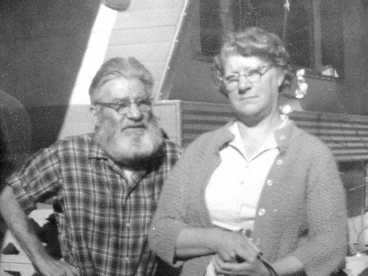
Original owners Frank & Esther Haines

Esther liked bright colors, and painted the car Lime Green

This is how it looked after the middle-man repainted it.
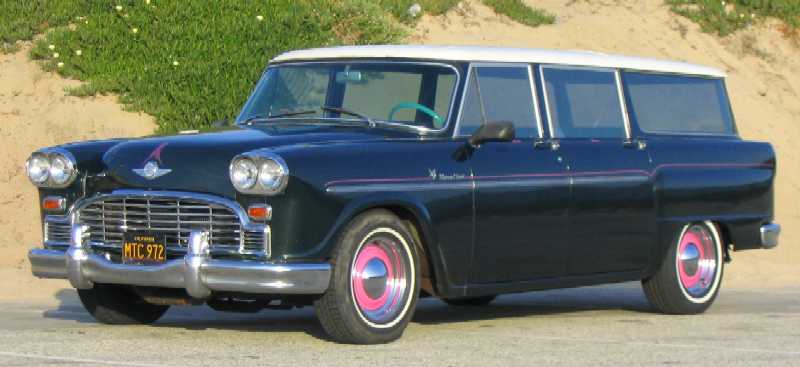
Upholstery by Cabrillo Top Shop, San Pedro, CA
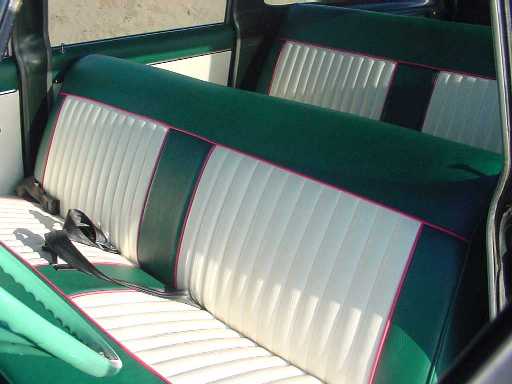
Drive train installation by Ron Koch, AutoRite Garage, Manhattan Beach, CA

Pinstriping and lettering by Mike Schartel, Schartel's Pinstriping, Hesperia, CA
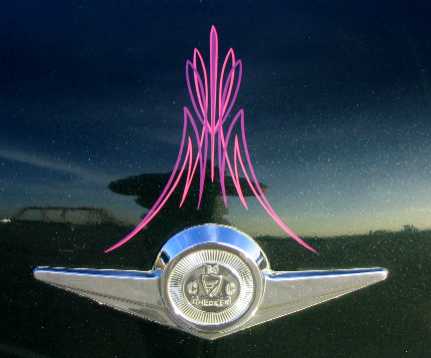
Every family member has their door personalized.
Good thing there are only four of us.
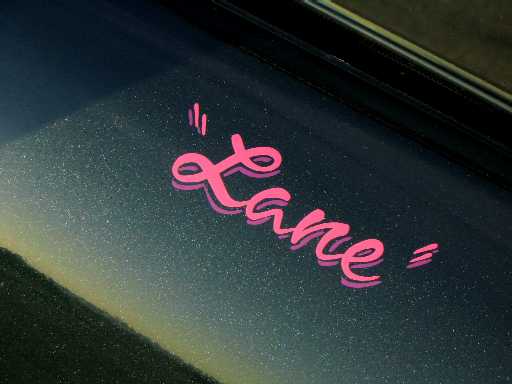
Lane Darnton
As far as I knew in March 2000, I was perfectly
happy with the cars I owned: a 1997 Nissan Quest minivan, and a 1994 Ford
Aspire – the latter so named, I suppose, because it aspired to be a car
when it grew up. I bought it because it was the best cheap car I could
find to get my wife reliably to work and back in Washington DC. I bought
the van to drive my family back to Los Angeles from Maryland towing a small
sailboat. The Aspire had a 5-speed, and I figured to teach my daughters
to drive in it. Or I did until my wife got it sandwiched on the 405 in LA.
It drove fine afterwards, but it was totaled. That’s what you get with “crumple zones”: no one hurt, but the car was toast. I was devastated. I wanted that car. I couldn’t afford a new car. I moped for three days until my exasperated wife said:
“Look, it’s gone. Get over it. We have to get another car. What kind of car do you WANT?”
It was not a question I had entertained, focused as I was on another Aspire, but after a moment’s thought I felt a little spark in the nether regions of my brain:
“A Checker wagon.”
“Well, have you LOOKED???”
It drove fine afterwards, but it was totaled. That’s what you get with “crumple zones”: no one hurt, but the car was toast. I was devastated. I wanted that car. I couldn’t afford a new car. I moped for three days until my exasperated wife said:
“Look, it’s gone. Get over it. We have to get another car. What kind of car do you WANT?”
It was not a question I had entertained, focused as I was on another Aspire, but after a moment’s thought I felt a little spark in the nether regions of my brain:
“A Checker wagon.”
“Well, have you LOOKED???”
No, I hadn’t. So I walked upstairs, flipped
on the computer, googled “Checker automobiles for sale”, and there it
was: a 1965 Checker wagon, one owner, showroom original except for paint,
always garaged, everything reputedly working, 61,790 California miles,
no rust, $9500. The ad was three weeks old. The price was the only thing
I didn’t like. I was thinking maybe $5000.
Original owners Frank & Esther Haines
Esther liked bright colors, and painted the car Lime Green

This is how it looked after the middle-man repainted it.
A couple weeks later my brother and I were
on our way north to Mt Shasta, CA with a $7500 cashier’s check, $2000
in cash, and the naïve notion that I was going to negotiate the guy
down. But he was a middle man and attached to nothing but money. He’d already
swindled Esther’s guileless granddaughter Cheryl, and I was next on his
list, so any “negotiation” required finding defects not previously disclosed.
The only thing not working was the overdrive solenoid, so I offered $9200,
he accepted, and the deal was done. Screw it, I thought, he’s
got the money, but I’ve got the car.
I drove it 610 miles back to LA at 60 mph with no OD, the 283 V8 turning 3250 rpm on a fortuitously cool, drizzly early May weekend, the engine temperature skating up around 220 degrees. Once home I put it on jacks, crawled under with a live 12 volt wire, and hot-wired the overdrive. It was just sticky from four years of disuse after Esther died in 1996. The fix took ten minutes.
On to bigger things. Joe Pollard, Mr. Checkerparts.com, had impressed on me the importance of disk brakes, but being parsimonious I decided to test his claim. I conducted a series of test stops starting at 50 mph and moving up in 5 mph increments, resting the brakes thoroughly in between. From 60 it was still passable. From 65 it could barely come to a stop. From 70 I couldn’t get the car below 30 mph. It was as if the brakes had been greased. Since freeway speed around here is 75 mph, it was time to talk to Joe.
And so began the most protracted, expensive, and frustrating automotive modification I’ve experienced in 31 years of messing around with cars. Nine weeks and $5000 later I had my car back, and for quite awhile I didn’t care if I never saw Joe or his friend Bobby Ellis at Family Automotive again. The estimate had been $2200. The car was nearly three inches lower in front with no increase in spring rate, the crossmember dragged on the ground routinely, the turning radius was double what it had been, the brake pads were dragging and wearing out, and the steering geometry was so cockeyed the front tires were scrubbing themselves to death. It looked cool, but was nearly useless – which was bad, because it was my daily driver.
I’ve since made peace with Joe, but it took two years and a lot more $$ to fully recover from the botched job. Joe is a nice guy, not a malicious bone in his body — shoot, he let me drive his ’82 propane cab for the entire nine weeks for nothing but the price of fuel — and he knows a LOT about Checkers . . . but not everything. And in areas where he lacks knowledge, his customers pay the price of his learning curve. It aggravates matters that Checker owners are usually getting parts from one person and labor from another, so no one is responsible but themselves, which can be costly. In the end, a few hours of crawling around his Mojave, CA junkyard taking pictures and making measurements filled in the missing knowledge. I put spacers in the springs to correct the ride height, I figured out the steering geometry problem (wrong steering arms) which also solved the steering radius mystery, and Joe exchanged the steering arms for free. I got 42,000 miles on the next set of tires, and I only replaced them ‘cuz I burned up the rears hot-rodding around with my new motor.
These troubles explain why I was glad to rediscover, in 2002 after a decade of not knowing where he’d got to, Ron Koch, now owner of AutoRite Garage. They don’t come any better than Ron. Suddenly my next project, an end-to-end drive train replacement, was a possibility.
I had these goals:
Of course, I only get that mileage when I drive like an old lady. Which I don’t, most of the time. “Your mileage may vary”. My brother’s comment — “You’ll get used to it” — was right on. What fun is power if you don’t use it?
The new level of performance was getting me into 3-digit speeds, so the soggy front suspension was no longer just annoying but dangerous. I pored through Ron’s Moog Springs catalog, found what I wanted, bought ‘em, cut ‘em, ground ‘em, installed ‘em, and increased my front spring rate 95%. The car is still two inches lower than stock in front, but now it doesn’t scrape pavement when I brake.
We followed with pink and purple pinstriping on the forest green metalflake, plus custom-offset Wheel Vintiques chrome smoothies with pinstriped pink centers and baby moons, and a new green and white interior with pink piping to match the striping. We added T-rated white sidewalls, and the car was done.
I drove it 610 miles back to LA at 60 mph with no OD, the 283 V8 turning 3250 rpm on a fortuitously cool, drizzly early May weekend, the engine temperature skating up around 220 degrees. Once home I put it on jacks, crawled under with a live 12 volt wire, and hot-wired the overdrive. It was just sticky from four years of disuse after Esther died in 1996. The fix took ten minutes.
On to bigger things. Joe Pollard, Mr. Checkerparts.com, had impressed on me the importance of disk brakes, but being parsimonious I decided to test his claim. I conducted a series of test stops starting at 50 mph and moving up in 5 mph increments, resting the brakes thoroughly in between. From 60 it was still passable. From 65 it could barely come to a stop. From 70 I couldn’t get the car below 30 mph. It was as if the brakes had been greased. Since freeway speed around here is 75 mph, it was time to talk to Joe.
And so began the most protracted, expensive, and frustrating automotive modification I’ve experienced in 31 years of messing around with cars. Nine weeks and $5000 later I had my car back, and for quite awhile I didn’t care if I never saw Joe or his friend Bobby Ellis at Family Automotive again. The estimate had been $2200. The car was nearly three inches lower in front with no increase in spring rate, the crossmember dragged on the ground routinely, the turning radius was double what it had been, the brake pads were dragging and wearing out, and the steering geometry was so cockeyed the front tires were scrubbing themselves to death. It looked cool, but was nearly useless – which was bad, because it was my daily driver.
I’ve since made peace with Joe, but it took two years and a lot more $$ to fully recover from the botched job. Joe is a nice guy, not a malicious bone in his body — shoot, he let me drive his ’82 propane cab for the entire nine weeks for nothing but the price of fuel — and he knows a LOT about Checkers . . . but not everything. And in areas where he lacks knowledge, his customers pay the price of his learning curve. It aggravates matters that Checker owners are usually getting parts from one person and labor from another, so no one is responsible but themselves, which can be costly. In the end, a few hours of crawling around his Mojave, CA junkyard taking pictures and making measurements filled in the missing knowledge. I put spacers in the springs to correct the ride height, I figured out the steering geometry problem (wrong steering arms) which also solved the steering radius mystery, and Joe exchanged the steering arms for free. I got 42,000 miles on the next set of tires, and I only replaced them ‘cuz I burned up the rears hot-rodding around with my new motor.
These troubles explain why I was glad to rediscover, in 2002 after a decade of not knowing where he’d got to, Ron Koch, now owner of AutoRite Garage. They don’t come any better than Ron. Suddenly my next project, an end-to-end drive train replacement, was a possibility.
I had these goals:
The answer was a Chevy Ram Jet 350 Port Fuel Injected crate motor from GM Performance Parts, a “Level 2” TH700r4 tranny from Bowtie Overdrives, a B&M “Quicksilver” ratchet floor shifter, a Dana 44 rear axle out of a 1981 Checker, and a 3.31 ring and pinion out of an earlier Checker. Ron did the whole job in ten calendar days for $3500 in labor, and I was one happy Checkerhead. I’ve already put 45,000 miles on this drivetrain. The car, all 4321 lbs of it including me, now launches at 0.73g, does 0-60 in 6.7 seconds, turns a 14.58 second, 95 mph quarter mile, and gets exactly 20.0 mpg at 65 mph. That's what I call a daily driver.
- at least one of the motor’s numbers — displacement, HP, or torque — had to start with “4”,
- the tranny had to be an automatic OD with lock-up,
- the rear end had to stand up to the new torque,
- the overall performance had to beat the 1966 SS396 El Camino I’d once owned,
- it had to be capable of 20 mpg at 65 mph,
- the total down time had to be less than two weeks, and finally
- I wanted electronic fuel injection.
Of course, I only get that mileage when I drive like an old lady. Which I don’t, most of the time. “Your mileage may vary”. My brother’s comment — “You’ll get used to it” — was right on. What fun is power if you don’t use it?
The new level of performance was getting me into 3-digit speeds, so the soggy front suspension was no longer just annoying but dangerous. I pored through Ron’s Moog Springs catalog, found what I wanted, bought ‘em, cut ‘em, ground ‘em, installed ‘em, and increased my front spring rate 95%. The car is still two inches lower than stock in front, but now it doesn’t scrape pavement when I brake.
We followed with pink and purple pinstriping on the forest green metalflake, plus custom-offset Wheel Vintiques chrome smoothies with pinstriped pink centers and baby moons, and a new green and white interior with pink piping to match the striping. We added T-rated white sidewalls, and the car was done.
Upholstery by Cabrillo Top Shop, San Pedro, CA
Drive train installation by Ron Koch, AutoRite Garage, Manhattan Beach, CA
Pinstriping and lettering by Mike Schartel, Schartel's Pinstriping, Hesperia, CA
Every family member has their door personalized.
Good thing there are only four of us.
